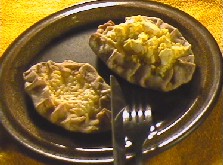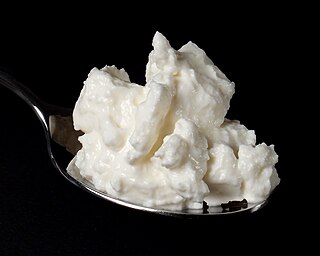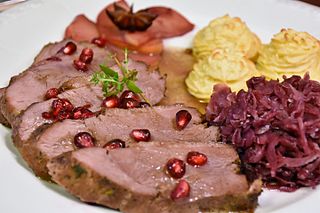 W
WA blood sausage is a sausage filled with blood that is cooked or dried and mixed with a filler until it is thick enough to solidify when cooled. Pig, cow, horse, donkey, sheep, chicken, duck, and goat blood can be used, varying by country.
 W
WBlodplättar, or blood pancakes in English, are a dish served in Finland, Estonia, Sweden and Norway made of whipped blood, water or pilsner, flour and eggs. It is similar to black pudding, but is thinner and crispier.
 W
WEgg butter is a mixture of butter and chopped hard boiled eggs. It is a well known spread in Finnish cuisine and Estonian cuisine.
 W
WHead cheese or brawn is a cold cut terrine or meat jelly, often made with flesh from the head of a calf or pig, typically set in aspic, that originated in Europe. Usually eaten cold, at room temperature, or in a sandwich, the dish is, despite the name, not a dairy cheese. The parts of the head used in the dish vary, though commonly do not include the brain, eyes or ears of the animal. The tongue, and sometimes the feet and heart of the animal may be included; the dish is also made using trimmings from more commonly eaten cuts of pork and veal, with the addition of gelatin as a binding agent. Head cheese may also be made without using the flesh from the head of an animal.
 W
WKama or talkkuna or tolokno is a traditional Estonian and Finnish and Russian finely milled flour mixture. The kama or talkkuna powder is a mixture of roasted barley, rye, oat and pea flour. The oat flour may be completely replaced by wheat flour, or kibbled black beans may be added to the mixture. In Finland kama is made by first steaming grains, then grounding them up and finally roasting them into kama.
 W
WKarelian pasties, Karelian pies or Karelian pirogs are traditional pasties or pirogs originating from the region of Karelia. They are eaten throughout Finland as well as in adjacent areas such as Estonia and northern Russia.
 W
WKissel or kisel is a viscous fruit dish, popular as a dessert and as a drink in Northern, Central and Eastern Europe. It consists of the sweetened juice of berries, like mors, but it is thickened with cornstarch, potato starch or arrowroot; sometimes red wine or fresh or dried fruits are added. It is similar to the Danish rødgrød and German Rote Grütze. Swedish blåbärssoppa is a similarly prepared bilberry dessert.
 W
WKringle is a Northern European pastry, a variety of pretzel. Pretzels were introduced by Roman Catholic monks in the 13th century in Denmark, and from there they spread throughout Scandinavia and evolved into several kinds of sweet, salty or filled pastries, all in the shape of kringle.
 W
WKvass is a traditional fermented Slavic and Baltic beverage commonly made from rye bread, which is known in many Central and Eastern European and Asian countries as "black bread". The colour of the bread used contributes to the colour of the resulting drink. Kvass's alcohol content from fermentation is typically low. It may be flavoured with fruits such as strawberries or raisins, or with herbs such as mint. Kvass is especially popular in Russia.
 W
WLingonberry jam is a staple of Northern European cuisine and otherwise highly popular in Central and Eastern Europe. Lingonberries grow on a short evergreen shrub in the Arctic tundra throughout the Northern Hemisphere from Eurasia to North America.
 W
WLivonian cuisine consists of the cuisine of Livonia and the Livonians, and is characterized by the rich use of local foods. Livonians are a coastal people – since they acquire the bulk of their food from the sea, Livonian families have historically eaten a great deal of fish. The most preferred of these is European flounder, but many also consume herring (ēriņ), salted herring, and cod (tūrska).
 W
WMaiasmokk is an old café in the capital city of Tallinn, Estonia that is located at the address of Pikk tn 16. It is said to have finished in its modern form in 1864, making it the oldest operational café in Estonia. The premises also contain a museum about the history and uses of marzipan. It is currently owned by the Kalev company.
 W
WMarzipan is a confection consisting primarily of sugar, honey, and almond meal, sometimes augmented with almond oil or extract.
 W
WQuark or quarg is a type of fresh dairy product made by warming soured milk until the desired amount of curdling is achieved, and then straining it. It can be classified as fresh acid-set cheese. Traditional quark can be made without rennet, but in modern dairies small quantities of rennet are typically added. It is soft, white and unaged, and usually has no salt added. It is traditional in the cuisines of Baltic, Germanic and Slavic-speaking countries.
 W
WRoast goose is a dish found in Chinese, European, and Middle Eastern cuisines. The goose is in the biological family of birds including ducks, geese, and swans, known as the family of Anatidae. The family has a cosmopolitan distribution. Roasting is a cooking method using dry heat with hot air enveloping the food, cooking it evenly on all sides. Roasting can enhance flavor. Many varieties of roast goose appear in cuisines around the world.
 W
WSepik is an Estonian whole wheat bread. Sepik is prepared with wheat flour or with a mixture that can contain wheat, rye, and barley flour. Additionally it can contain bran.
 W
WSmörgåstårta is a dish of Swedish origin popular in Sweden, Estonia, Finland and Iceland. It is a savoury cake that is similar to a sandwich, but with large amounts of filling and garnish, similar to a layered cream cake.
 W
WVispipuuro, vispgröt/klappgröt/klappkräm or mannavaht is a sweet, wheat semolina (manna) dessert porridge made with berries, usually lingonberries. It is eaten in Finland, Sweden and Estonia. The semolina is cooked with the berries and also some kind of sweetener. Note that in Sweden, it's usually made by adding lingonberry cordial to the water, in which the semolina is cooked, as the texture is supposed to be smooth, so you don't want little bits of berries in the porridge. After the mixture has cooled down, the porridge is vigorously whipped to a light, mousse-like consistency. Alternatively, the pot the porridge was made in, can be put in the kitchen sink, partially filled with water and whisk it in there, so it cools down while being whisked with a hand mixer. The dessert is usually served with milk and optionally sugar. Other berries and fruit that can be used are redcurrants, cranberries, apricots, gooseberries and strawberries.